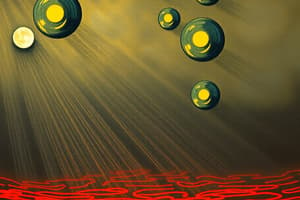Podcast
Questions and Answers
What defines an object as having high thermal energy?
What defines an object as having high thermal energy?
- High molecular movement (correct)
- Low molecular movement
- Absence of heat transfer
- Presence of a heat source
Which of the following best describes heat?
Which of the following best describes heat?
- The total thermal energy in a system
- Movement of thermal energy from cold to hot
- Movement of thermal energy from hot to cold (correct)
- The energy stored in an object
In which scenario does thermal energy transfer occur through conduction?
In which scenario does thermal energy transfer occur through conduction?
- Warm air rising in a room
- Toasting a marshmallow above a flame
- Water boiling in a pot
- Hands warming by rubbing together (correct)
What is convection dependent on?
What is convection dependent on?
When thermal energy is transferred to an object, what typically happens to its particles?
When thermal energy is transferred to an object, what typically happens to its particles?
Which of the following is NOT a method of thermal energy transfer?
Which of the following is NOT a method of thermal energy transfer?
How does thermal energy enable cooking and baking?
How does thermal energy enable cooking and baking?
Why is thermal energy essential for life on Earth?
Why is thermal energy essential for life on Earth?
What happens to particles in a fluid as they become warmer?
What happens to particles in a fluid as they become warmer?
Which method of thermal energy transfer occurs through physical contact between two objects?
Which method of thermal energy transfer occurs through physical contact between two objects?
How does thermal energy transfer occur during the toasting of marshmallows?
How does thermal energy transfer occur during the toasting of marshmallows?
What type of energy is thermal energy classified as?
What type of energy is thermal energy classified as?
In which scenario is convection demonstrated?
In which scenario is convection demonstrated?
What kind of waves are responsible for the transfer of thermal energy via radiation?
What kind of waves are responsible for the transfer of thermal energy via radiation?
What occurs when colder particles in a pot gain heat?
What occurs when colder particles in a pot gain heat?
Flashcards
Thermal Energy
Thermal Energy
The energy in an object or system due to the movement of its molecules and atoms.
Heat
Heat
The movement of thermal energy from a higher concentration to a lower concentration.
Convection
Convection
A type of thermal energy transfer due to differences in temperature in fluids (like water or air).
Conduction
Conduction
Signup and view all the flashcards
Radiation
Radiation
Signup and view all the flashcards
Thermal Energy Transfer
Thermal Energy Transfer
Signup and view all the flashcards
Heat Energy
Heat Energy
Signup and view all the flashcards
Examples of Thermal Energy
Examples of Thermal Energy
Signup and view all the flashcards
Convection
Convection
Signup and view all the flashcards
Conduction
Conduction
Signup and view all the flashcards
Radiation
Radiation
Signup and view all the flashcards
Thermal Energy
Thermal Energy
Signup and view all the flashcards
Kinetic Energy
Kinetic Energy
Signup and view all the flashcards
Heat
Heat
Signup and view all the flashcards
Electromagnetic Waves
Electromagnetic Waves
Signup and view all the flashcards
Study Notes
Thermal Energy
-
Definition: Thermal energy is the energy in an object or system due to the movement of its molecules and atoms. Faster-moving particles mean more thermal energy.
-
Heat: Heat is the movement of thermal energy from a higher concentration (hotter object) to a lower concentration (colder object).
-
Relationship to "Heat Energy": Often called "heat energy" due to its close connection to heat transfer.
Thermal Energy Examples
- Everyday occurrences: Boiling water, rubbing hands together, toasting marshmallows.
- Applications: Cooking, heating homes, keeping bodies warm, life on Earth (due to solar energy).
How Thermal Energy Works
- Transfer: Thermal energy is transferred from objects with high thermal energy to objects with less. This transfer results in faster-moving particles in the receiving object.
- Types of Transfer:
- Convection: Transfer due to temperature differences in fluids (liquids and gases). Warmer, less dense fluids rise, while cooler, denser fluids sink, creating a cycle.
- Conduction: Transfer through direct contact between objects. Faster-moving particles in the warmer object jostle slower-moving particles in the cooler object, increasing their energy.
- Radiation: Transfer through electromagnetic waves, allowing energy to travel through space (e.g., from the sun to Earth, or from a fire toasting a marshmallow).
Convection
- Mechanism: Difference in temperature leads to density differences in fluids. Warmer fluids rise; cooler fluids sink.
- Examples: Boiling water, ocean breezes, radiators, hot air balloons.
Conduction
- Mechanism: Transfer through direct contact.
- Examples: Ironing a shirt, ice melting, laying on a heating pad, burning on a hot pan.
Radiation
- Mechanism: Transfer through electromagnetic waves.
- Examples: Toasting marshmallows, warming by a fire, warmth from the sun. Crucial for life on Earth.
What Type of Energy is Thermal Energy?
- Kinetic Energy: Thermal energy is a type of kinetic energy because it is related to the motion of particles.
Studying That Suits You
Use AI to generate personalized quizzes and flashcards to suit your learning preferences.




